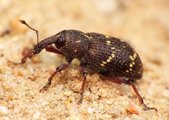Підтримуємо Вільну Україну
 We Support Free Ukraine
We Support Free Ukraine

Biodiversity Map
Taxa

Callirus — subordinate taxa:
Taxon count: 3
-
Arthropodaphylum
Click to switch
to select orders
and filters > -
Hexapodasubphylum
Click to switch
to select orders
and filters > -
Insectaclass
Click to switch
to select orders
and filters > -
Coleopteraorder
Click to set
as the main taxon
and as a base
← of the left panel > -
Polyphagasuborder
Click to set
as the main taxon
and as a base
← of the left panel > -
Cucujiformiaseries
Click to set
as the main taxon
and as a base
← of the left panel > -
Curculionoideasuperfamily
Click to set
as the main taxon
and as a base
← of the left panel > -
Curculionidaefamily
Click to set
as the main taxon
and as a base
← of the left panel > -
Molytinaesubfamily
Click to set
as the main taxon
and as a base
← of the left panel > -
Hylobiinitribe
Click to set
as the main taxon
and as a base
← of the left panel > -
Hylobiusgenus
Click to set
as the main taxon
and as a base
← of the left panel > -
Callirussubgenus
Click to set
as the main taxon
and as a base
← of the left panel >
PL
YES
name status: valid name
BioMap ID: 1046942
taxon code: 5382
taxonomy checked: YES
Data on distribution in Poland

Statistics
- Records: 249
- Publications: 87
- Collections: 11
- Publication authors: 80
- Illustrations (iconography): 1
- Photos (specimen/observation): 1
Taxon description
Gatunek występujący niemal w całej Europie (z wyjątkiem obszarów północnych Fennoskandii), docierający na wschód przez Syberię do Mongolii. W Polsce szeliniak mniejszy jest znany głównie z terenów nizinnych i wyżyn; notowano go ponadto z niższych partii Sudetów i Beskidów. Zasiedla sosnę zwyczajną — Pinus silvestris L., rzadziej świerk pospolity — Picea excelsa (Lam.) Lk. Postacie dojrzałe żerują na korze, niekiedy uszkadzają również miazgę, a sporadycznie ogryzają także igły. Larwy żerują w łyku, następnie w bielu. Cykl rozwojowy podobny jak u H. abietis (L.).
Illustrations
... browse
 Hylobius
Hylobiuspinastri
Photos
... browse
 Hylobius
Hylobiuspinastri
External data sources
- Ostatnie rekordy
-
1140909
 ⊡
⊡ Curculionidae: Hylobius pinastri, PL, Pojezierze Pomorskie, Pojezierze Południowopomorskie, Równina Charzykowska, P.N. Borów Tucholskich, pomorskie, Chojnice, Chojnice w., ad Bachorze, UTM XV66, 1998 (Gutowski et al. 2005a)
Curculionidae: Hylobius pinastri, PL, Pojezierze Pomorskie, Pojezierze Południowopomorskie, Równina Charzykowska, P.N. Borów Tucholskich, pomorskie, Chojnice, Chojnice w., ad Bachorze, UTM XV66, 1998 (Gutowski et al. 2005a) -
1112854
 ⊡
⊡ Curculionidae: Hylobius pinastri, PL, Górny Śląsk, Tworóg, UTM CB30, 2008, leg. H. Szołtys
Curculionidae: Hylobius pinastri, PL, Górny Śląsk, Tworóg, UTM CB30, 2008, leg. H. Szołtys -
1100015
 ×
× Curculionidae: Hylobius pinastri, PL, Białowieski P.N., Białowieża, 1937, leg. A. Gottwald, coll. IBL, Zakład Ochrony Lasu, Sękocin: Gottwald
Curculionidae: Hylobius pinastri, PL, Białowieski P.N., Białowieża, 1937, leg. A. Gottwald, coll. IBL, Zakład Ochrony Lasu, Sękocin: Gottwald -
1100014
 ×
× Curculionidae: Hylobius pinastri, PL, Białowieski P.N., Białowieża, 1937, leg. A. Gottwald, coll. IBL, Zakład Ochrony Lasu, Sękocin: Gottwald
Curculionidae: Hylobius pinastri, PL, Białowieski P.N., Białowieża, 1937, leg. A. Gottwald, coll. IBL, Zakład Ochrony Lasu, Sękocin: Gottwald -
1100013
 ×
× Curculionidae: Hylobius pinastri, PL, Ndl. Białowieża, 1937, leg. A. Gottwald, coll. IBL, Zakład Ochrony Lasu, Sękocin: Gottwald
Curculionidae: Hylobius pinastri, PL, Ndl. Białowieża, 1937, leg. A. Gottwald, coll. IBL, Zakład Ochrony Lasu, Sękocin: Gottwald -
1099807
 ×
× Curculionidae: Hylobius pinastri, PL, Gołdap, 1953, leg. Zb. Schnaider, coll. IBL, Zakład Ochrony Lasu, Sękocin: Gottwald
Curculionidae: Hylobius pinastri, PL, Gołdap, 1953, leg. Zb. Schnaider, coll. IBL, Zakład Ochrony Lasu, Sękocin: Gottwald -
1099806
 ×
× Curculionidae: Hylobius pinastri, LT, wileńskie, leg. , coll. IBL, Zakład Ochrony Lasu, Sękocin: Gottwald
Curculionidae: Hylobius pinastri, LT, wileńskie, leg. , coll. IBL, Zakład Ochrony Lasu, Sękocin: Gottwald -
1099805
 ×
× Curculionidae: Hylobius pinastri, PL, 1957, coll. IBL, Zakład Ochrony Lasu, Sękocin: Gottwald
Curculionidae: Hylobius pinastri, PL, 1957, coll. IBL, Zakład Ochrony Lasu, Sękocin: Gottwald -
1099804
 ×
× Curculionidae: Hylobius pinastri, PL, 1957, coll. IBL, Zakład Ochrony Lasu, Sękocin: Gottwald
Curculionidae: Hylobius pinastri, PL, 1957, coll. IBL, Zakład Ochrony Lasu, Sękocin: Gottwald -
1099803
 ×
× Curculionidae: Hylobius pinastri, PL, 1960, coll. IBL, Zakład Ochrony Lasu, Sękocin: Gottwald
Curculionidae: Hylobius pinastri, PL, 1960, coll. IBL, Zakład Ochrony Lasu, Sękocin: Gottwald - ... more
- Powiązane publikacje
-
Gutowski J.M., Kubisz D., Sućko K., Zub K. 2010b. Sukcesja saproksylicznych chrząszczy (Coleoptera) na powierzchniach pohuraganowych w drzewostanach sosnowych Puszczy Piskiej. Leś. Pr. Bad., 71:279-298.
 Show records
Show records -
Starzyk J.R., Grodzki W., Kosibowicz M., Michalcewicz J., Rossa R. 2008c. Stare i martwe drzewa jako miejsce występowania chrząszczy ksylobiontycznych i dendrofilnych. Roczn. Bieszcz., 16:325-348.
 Show records
Show records -
Sprick P., Floren A. 2007. Canopy leaf beetles and weevils in the Białowieża and Borecka Forests in Poland (Col., Chrysomeloidea, Curculionoidea). Pol. Pismo Ent., 76:75-100.
 Show records
Show records -
Rutkiewicz A. 2007b. Waloryzacja lasów Gór Świętokrzyskich na podstawie struktury zgrupowań chrząszczy saproksylicznych powierzchni pni drzew. [In:] Borowski J., Mazur S. (Eds.) Waloryzacja ekosystemów leśnych Gór Świętokrzyskich metodą zooindykacyjną. Wydawnictwo SGGW, Warszawa. pp. 20-56.
 Show records
Show records -
Mokrzycki T. 2007. Waloryzacja ekosystemów leśnych Gór Świętokrzyskich na podstawie struktury zgrupowań chrząszczy związanych z pniakami. [In:] Borowski J., Mazur S. (Eds.) Waloryzacja ekosystemów leśnych Gór Świętokrzyskich metodą zooindykacyjną. Wydawnictwo SGGW, Warszawa. pp. 148-193.
 Show records
Show records - ... more
- Powiązane zbiory
-
Białooki P.*
 Show records
Show records -
ISEZ PAN
 Show records
Show records -
Kuśka A.*
 Show records
Show records -
Muz. Górnośląskie, Bytom: Mączyński
 Show records
Show records -
SGGW KOLiE
 Show records
Show records - ... more
- Wykaz powiązanych pozycji
-
Curculionoidea of Poland
 Show records
Show records -
Weevils of the Tatra Mts.
 Show records
Show records






